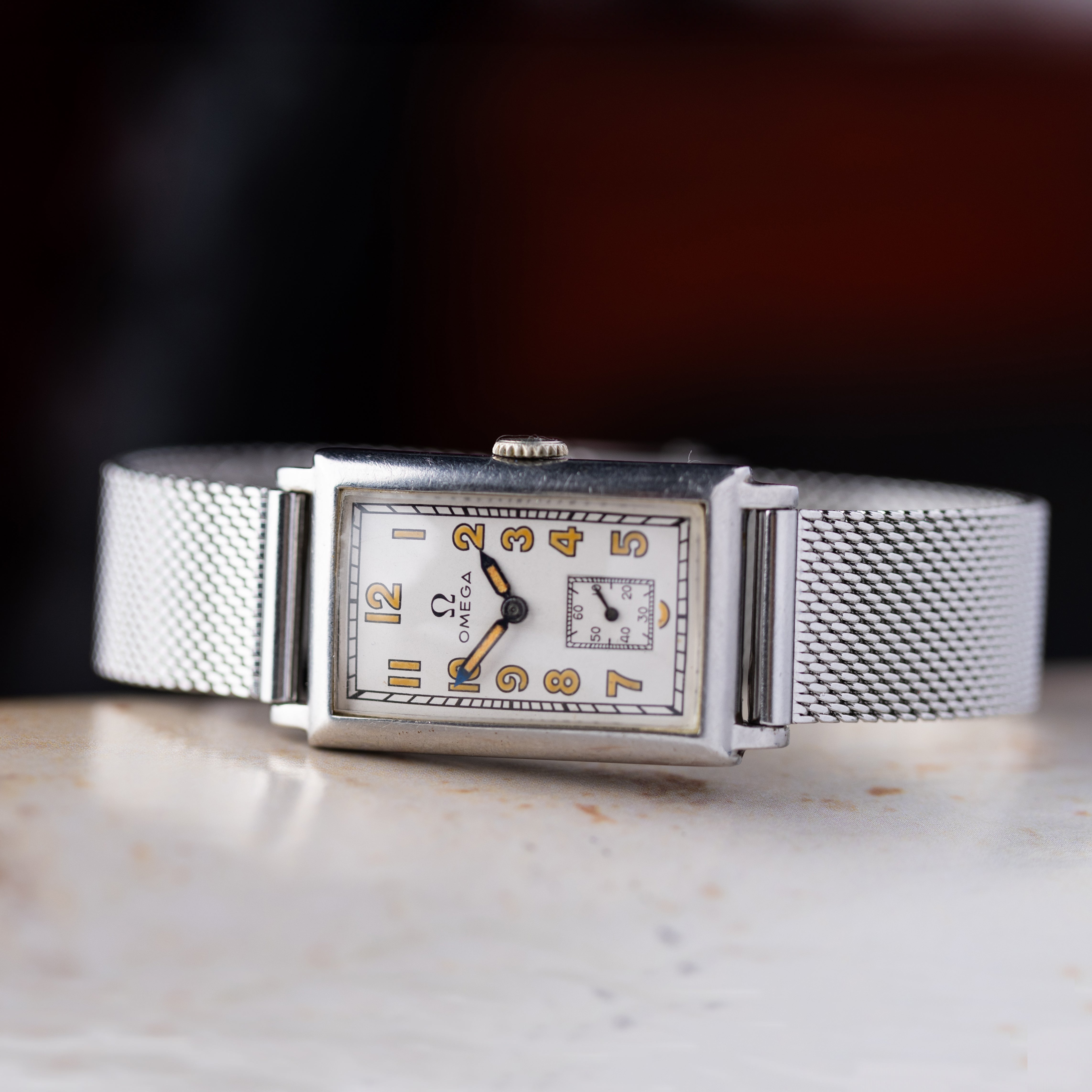Introduction
During World War II, accurate and reliable timekeeping was critical for military operations. From coordinating attacks to timing artillery strikes, soldiers needed a robust wristwatch that could withstand the harsh conditions of war. While the British military had historically relied on high-quality timepieces—ranging from naval chronometers to trench watches—it became clear that local manufacturers could not meet the growing demand for military-issued wristwatches.
Faced with this challenge, the British Ministry of Defence (MoD) turned to Switzerland, home to some of the finest watchmakers in the world. In 1945, the MoD commissioned twelve Swiss watch brands to produce watches built to strict military specifications. The result was the "Dirty Dozen"—a collection of rugged, reliable, and highly functional military wristwatches designed to survive the battlefield.
Today, these watches are among the most sought-after military collectibles, with their historical significance and distinct design continuing to captivate vintage watch enthusiasts. In this article, we’ll explore their origins, technical specifications, the history of each brand that produced them, and why they remain highly desirable for collectors.

Photo Credit: Watches Of Knightsbridge
The Origins of the Dirty Dozen
By the early 1940s, British soldiers were still using a variety of civilian watches and pocket watches, many of which were unreliable or unsuited for the rigors of war. The MoD decided that an official military-issued wristwatch was needed—one that met specific durability, accuracy, and legibility requirements.
The specifications outlined by the MoD were clear and demanding:
- Black Dial: Ensured high contrast and readability.
- Arabic Numerals: Easy to read in low-light conditions.
- Luminous Hands & Hour Markers: Enabled time-checking in darkness.
- Railroad Minute Track: Allowed for precise time measurement.
- Shatterproof Crystal: Withstood impact and rough handling.
- Stainless Steel or Chrome-Plated Case: Provided water resistance and durability.
- Waterproof & Shockproof Design: Essential for battlefield conditions.
- 15-Jewel, Manually Wound Movement: Ensured longevity and reliability.
Each watch had military engravings on the case back, including:
- "W.W.W." (Watch, Wrist, Waterproof) – a standard military designation.
- Broad Arrow symbol – indicating British military property.
- Military serial number – a capital letter followed by up to five digits.
- Civilian serial number – sometimes located inside the case.
With production ramping up in mid-1945, approximately 150,000 Dirty Dozen watches were delivered. Although they were issued as "General Service" watches, they were often allocated to specialized military personnel such as artillery officers and radio operators.
In-Depth Look at Each Dirty Dozen Watch
Each of the twelve Swiss manufacturers brought their own expertise to the table, producing watches that adhered to the same specifications but with slight variations.
1. Buren – A Forgotten Pioneer
Founded in 1898, Buren was a respected Swiss watchmaker known for its high-quality pocket watches and early wristwatches. After the war, Buren developed the micro-rotor automatic movement, influencing modern watchmaking.
- Case: 36.5mm chrome-plated
- Movement: In-house Caliber 462
- Hands: Sword-style
Photo Credit: Vintage Watch Specialist
Though later absorbed by Hamilton and eventually the Swatch Group, Buren remains a lesser-known name in military watch history.
2. Cyma – The Reliable Workhorse
Cyma, established in 1862, was known for making robust and precisely regulated movements.
- Case: 37mm stainless steel (one of the largest Dirty Dozen cases)
- Movement: Caliber 234 (highly regarded for accuracy)
- Production: Estimated 20,000 units
Unlike many others, Cyma’s watch had a fully stainless steel case, making it more corrosion-resistant and highly sought after today.

Photo Credit: Vintage Watch Specialist
3. Eterna – Precision and Innovation
Eterna, founded in 1856, was instrumental in creating ETA SA, which remains one of the world’s largest movement manufacturers.
- Case: 36mm stainless steel
- Movement: In-house Caliber 520
- Production: Estimated 5,000 units
Post-war, Eterna gained recognition for the Eterna-Matic movement and the famous Kon-Tiki dive watch.

Photo Credit: Vintage Watch Specialist
4. Grana – The Holy Grail
Of all the Dirty Dozen watches, Grana is the rarest—making it the most desirable among collectors.
- Case: Stainless steel
- Production: Fewer than 5,000 units (some sources estimate as low as 1,000)
- Auction Prices: Frequently exceed $12,000+
Grana later evolved into Certina, but its WWII contribution remains legendary.

Photo Credit: Vintage Watch Specialist
5. Jaeger-LeCoultre (JLC) – The Watchmaker’s Watchmaker
JLC, one of Switzerland’s most prestigious brands, was known for its technical mastery.
- Case: 35mm chrome and steel
- Movement: In-house Caliber 479
- Hands: Cathedral-style
JLC’s later Mark XI pilot’s watch built upon the Dirty Dozen’s military legacy.

Photo Credit: Vintage Watch Specialist
6. Lemania – The Chronograph Specialist
Lemania was famous for producing high-end chronograph movements used by Omega and Breguet.
- Case: 36.5mm steel and chrome
- Movement: Caliber 27A
- Production: Estimated 8,000 units
Lemania’s partnership with Omega led to the Moonwatch movement used in the Speedmaster.
Photo Credit: Vintage Watch Specialist
7. Longines – The Aviation Legend
Founded in 1832, Longines has deep roots in aviation and military timekeeping.
- Case: 38mm stainless steel (largest of the Dirty Dozen watches)
- Movement: Caliber 12.68Z
Its Dirty Dozen watch was later nicknamed "The Greenlander", though incorrectly linked to the British North Greenland Expedition.

Photo Credit: Vintage Watch Specialist
8. IWC – The Future of Pilot Watches
IWC’s Dirty Dozen watch paved the way for the Mark XI pilot’s watch, a military legend.
- Case: 35mm stainless steel
- Movement: Caliber 83
IWC’s military watches remain among its most collectible timepieces.

Photo Credit: Vintage Watch Specialist
9. Omega – The Giant
Omega, one of the largest contributors, produced 25,000 units.
- Case: 35mm stainless steel
- Movement: Caliber 30T2
Its Dirty Dozen model is one of the most widely available yet highly valued due to Omega’s strong brand recognition.

Photo Credit: Vintage Watch Specialist
10. Record – The Underdog
- Case: 36.5mm chrome-plated
- Movement: Caliber 022K
Record was later absorbed into Longines, but its contribution to WWII history remains.

Photo Credit: Vintage Watch Specialist
11. Timor – The Resilient Brand
Timor has revived its Dirty Dozen design with a modern reissue.
- Case: 36.5mm chrome-plated
- Movement: Caliber 6060
Photo Credit: Vintage Watch Specialist
12. Vertex – The British Connection
Vertex was the only British-founded brand in the group.
- Case: 35mm chrome-plated
- Movement: Caliber 59
The brand was revived in 2015, with a modern M100 series inspired by the Dirty Dozen.

Photo Credit: Vintage Watch Specialist
Conclusion
The Dirty Dozen watches represent an unparalleled chapter in military watch history. Whether you’re a serious collector or a casual enthusiast, these watches offer a rare glimpse into wartime craftsmanship. Assembling a complete set is a challenge, but each watch tells a story of precision, resilience, and history—a story that continues to fascinate watch lovers to this day.




